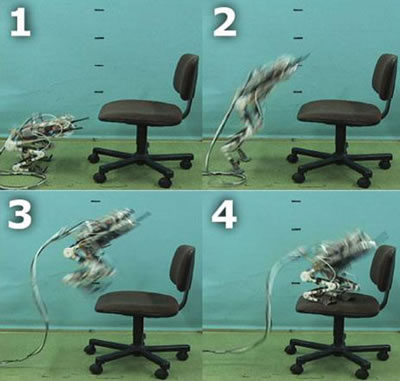Science Fiction
Dictionary
A B C D E F G H I J K L M N O P Q R S T U V W X Y Z
Mowgli Leaping Frog Robot

Mowgli is a robot that leaps like a frog thanks to its air-powered muscles. University of Tokyo engineers built this amazing robot, able to leap fifty centimeters into the air.

(Mowgli air-powered leaping frog robot)
Mowgli's expertise extends to more than simply jumping up. The leaping robot can also jump down safely.
(Mowgli air-powered leaping frog robot youtube video)
Here's what Ryuma Niiyama, Akihiko Nagakubo and Yasuo Kuniyoshi have to say about Mowgli:
Mowgli's artificial musculoskeletal system consists of six McKibben pneumatic muscle actuators including bi-articular muscle and two legs with hip, knee, and ankle joints. Mowgli can reach jump heights of more than 50% of its body height and can land softly. Our results show a proximo-distal sequence of joint extensions during jumping despite simultaneous motor activity. Extensions in the whole body motion are caused by the compliance and the natural dynamics of the legs. In addition to the experiments with the real robot, we also simulated two types of open loop controllers for vertical jumping with disturbance. We found that the model controlled by open loop motor command through a muscle-tendon mechanism could jump robustly. The simulation results demonstrate the contribution of the artificial musculoskeletal system as a physical feedback loop in explosive movements.
Mowgli joins the steadily increasing zoo of biomimetically inspired robots like the worm-like gummi bots, the lamprey robot and of course RoboSalmon, a swimming robot that keeps track of the real fish.
Via Air-powered leaping robot created in Tokyo and Mowgli: a jumping robot.
Scroll down for more stories in the same category. (Story submitted 10/1/2007)
Follow this kind of news @Technovelgy.| Email | RSS | Blog It | Stumble | del.icio.us | Digg | Reddit |
Would
you like to contribute a story tip?
It's easy:
Get the URL of the story, and the related sf author, and add
it here.
Comment/Join discussion ( 0 )
Related News Stories - (" Robotics ")
Proof Of Robothood - Not A Person
'Who are you people? - Show 'em.' - James Cameron (1984).
Dancing Robots Taught Dance Moves
'A clockwork figure would be the thing for you...' Jerome K. Jerome, 1893.
Factory Humanoid Robots Built By Humanoid Robots
'...haven't you a section of the factory where only robot labor is employed?' - Isaac Asimov (1940).
Mornine Sales Robot
'Robot-salesmen were everywhere, gesturing...' - Philip K Dick, 1954.
Technovelgy (that's tech-novel-gee!) is devoted to the creative science inventions and ideas of sf authors. Look for the Invention Category that interests you, the Glossary, the Invention Timeline, or see what's New.
Science Fiction
Timeline
1600-1899
1900-1939
1940's 1950's
1960's 1970's
1980's 1990's
2000's 2010's
Current News
Natural Gait With Prosthetic Connected To Nervous System
'The leg was to function, in a way, as a servo-mechanism operated by Larry’s brain...'
Woman Marries Computer, Vonnegut's Dream Comes True
'Men are made of protoplasm... Lasts forever.'
Spidery 'Walk Me' Toyota Autonomous Wheel Chair Like Star Wars
Walk along with the emperor.
Dancing Robots Taught Dance Moves
'A clockwork figure would be the thing for you...'
Proof Of Robothood - Not A Person
'Who are you people? - Show 'em.'
Indonesian Clans Battle
'The observation vehicle was of that peculiar variety used in conveying a large number of people across rough terrain.'
The 'Last Mile' In China Crowded With Delivery Robots
Yes, it's a delivery robot. On wheels.
Tornyol Microdrone Kills Mosquitoes
'The real border was defended by... a swarm of quasi-independent aerostats.'
PLATO Spacecraft, Hunter Of Habitable Planets, Now Ready
'I ... set my automatic astronomical instruments to searching for a habitable planet.'
Factory Humanoid Robots Built By Humanoid Robots
'...haven't you a section of the factory where only robot labor is employed?'
iPhone Air Fulfils Jobs' Promise From 2007 - A Giant Screen!
'... oblongs were all over the floor and surfaces.'
ChatGPT Now Participates in Group Chats
'...the city was their laboratory in human psychology.'
iPhone Pocket All Sold Out!
'A long, strong, slender net...'
Did The Yautja Have These First?
What a marvel of ingenuity the little device was!
Jetson ONE Air Races Begin, Can Air Polo Be Far Behind?
'If you're one of those rarities who haven't attended a rocket-polo "carnage", let me tell you it's a colorful affair.'
Will Space Stations Have Large Interior Spaces Again?
'They filed clumsily into the battleroom, like children in a swimming pool for the first time, clinging to the handholds along the side.'
